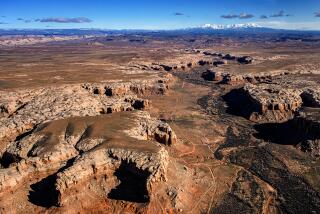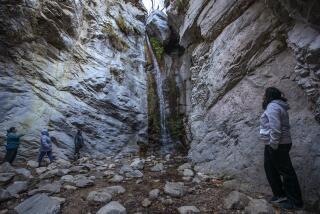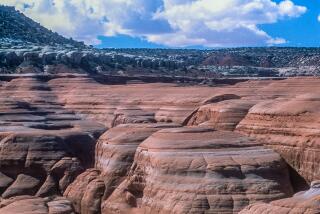Trump plans big cuts in two Utah national monument boundaries

In what would be an extraordinary test of a chief executive’s authority to revoke boundaries of the country’s national monuments, President Trump is expected to formally propose chopping Utah’s Bears Ears and Grand Staircase-Escalante monuments into five separate and much smaller national monuments.
A map of the proposed changes was made public by the Wilderness Society. Although the White House did not comment on the president’s monuments plan, the Interior Department said the leaked maps were accurate but not final.
The president is scheduled to make an announcement on the monuments during an appearance Monday in Salt Lake City.
Though presidents have trimmed boundaries 14 times since President Theodore Roosevelt established the first national monument under the 1906 Antiquities Act, no president has ever revoked a national monument or proposed such large changes in a monument’s acreage.
The map of proposed changes suggests that the president is prepared to reduce the 1.9-million-acre Grand Staircase-Escalante monument to under 1 million acres and split the remaining acreage into three new monuments — Grand Staircase National Monument, Kaiparowits National Monument and Escalante Canyons National Monument.
Under the new plan, the 1.35-million-acre Bears Ears National Monument also will be eliminated. Some of its acreage, reduced to just over 200,000 acres, would be placed in two new smaller entities, the Indian Creek National Monument and the Shash Jaa National Monument.
Utah Gov. Gary Herbert said the reported decision suggested Trump was “willing to listen to those who are most impacted by these monument designations … [including] those who live next to the monuments.”
“It seems to me he is trying to make sure that we’re following the law of the Antiquities Act,” Herbert said on the sidelines of a gathering of Western governors in Phoenix.
Utah’s senior Republican senator, Orrin G. Hatch, who objected to the establishment of both monuments in his state, issued this statement: “The details of the president’s announcement are his to make, but I appreciate his willingness to listen to my advice, and even more importantly, to give the people of Utah a voice in the process.”
The proposed changes in Bears Ears and Grand Staircase-Escalante were met with vehement opposition by Democratic lawmakers, Native American leaders and environmental groups. All asserted that the president does not have the legal authority to make such dramatic boundary changes or revoke a national monument designation. That authority lies exclusively with Congress, they said.
“They are in totally uncharted territory,” said New Mexico Democratic Sen. Tom Udall. “They don’t have any authority to do this. There is no authority under the Antiquities Act for anyone to modify, eliminate or reduce national monuments nor delegate that authority to anyone other than the U.S. Congress. This interpretation was supported by a 1938 opinion by Atty. Gen. Homer Cummings. This 80-year-old opinion has stood the test of time. No president has ever attempted to revoke a national monument.”
The Antiquities Act provides broad authority to presidents to establish national monuments. More than 150 national monuments safeguard roughly 77 million acres of historical, cultural sites and wildlands across the country, according to the Interior Department.
Trump’s actions follow an executive order in April that directed Interior Secretary Ryan Zinke to review all national monuments established since 1996.
In August, Zinke recommended diminishing the boundaries of Bears Ears and Grand-Escalante and changing the management of several other monuments. In October, the president alerted Hatch that he planned to shrink the boundaries of the two monuments.
Congress in 1976 approved the Federal Land Policy and Management Act, which asserted congressional authority to oversee public lands, including boundary changes in national monuments.
Five Native American tribes proposed establishing Bears Ears to protect 100,000 historic and cultural sites on the high mesa and deep canyons of southeast Utah. They worked with President Obama to establish the monument almost a year ago.
Tribal leaders said they were prepared to defend the Bears Ears boundaries in court.
“It is absolutely shocking. It is so disrespectful of the work that went into the monument,” said Ethel Branch, the attorney general of the Navajo Nation. “We will lead this lawsuit, which we call Navajo Nation vs. Trump.”
Times staff writer Kurtis Lee contributed to this report from Phoenix.
UPDATES:
5:45 p.m.: The story was updated with a quote from Utah’s governor.
The story was originally published at 12:15 p.m.
More to Read
Start your day right
Sign up for Essential California for news, features and recommendations from the L.A. Times and beyond in your inbox six days a week.
You may occasionally receive promotional content from the Los Angeles Times.






